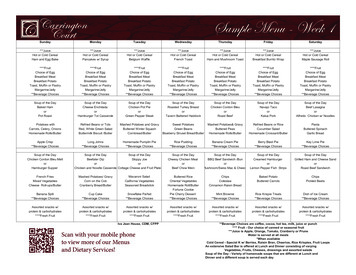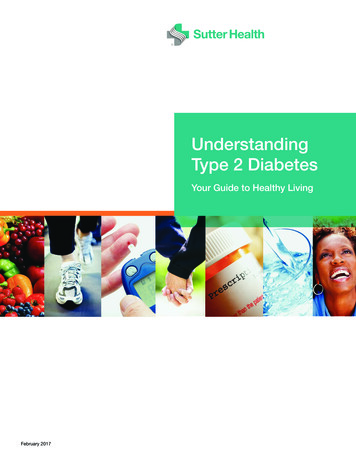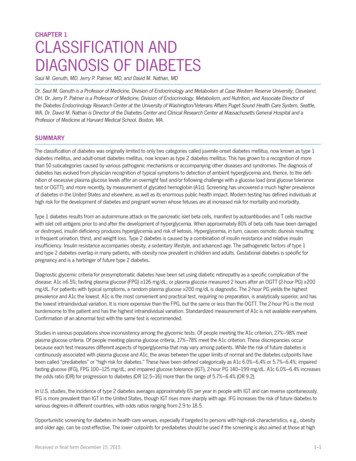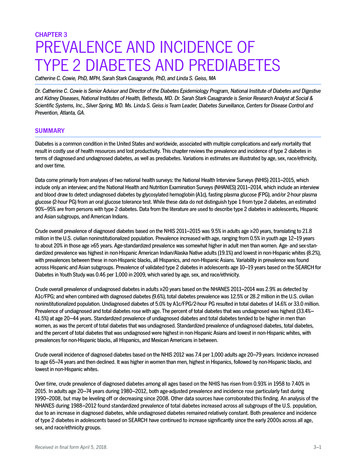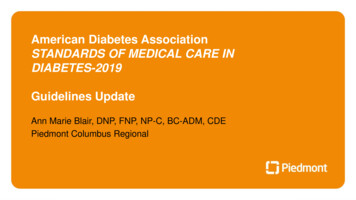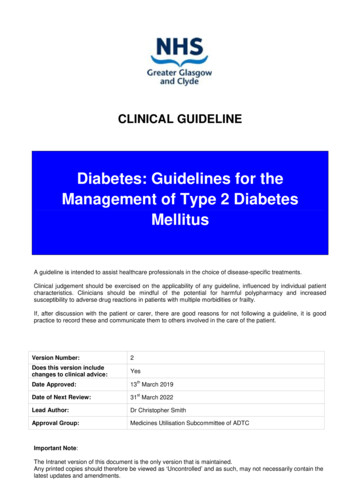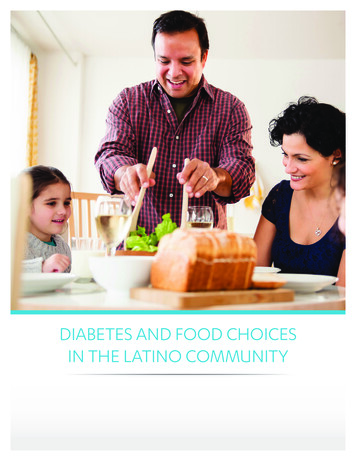
Transcription
DIABETES AND FOOD CHOICESIN THE LATINO COMMUNITY
DIABETES AND FOOD CHOICESIN THE LATINO COMMUNITYDiabetes is considered an urgent problem in the Latino community. Did you know that the ratesof diabetes for Latinos are almost double those of non-Latino whites?1 More than 10% of Hispanics/Latinos in the United States have been diagnosed with diabetes.2Staying HealthyWhat Is Type 2 Diabetes?You don’t have to give up foods you love tostay healthy and eat right when you have type 2diabetes. Choosing the right foods in the rightamounts can help you improve your overallhealth.3 Remember that you may have to play animportant role, along with your healthcare team,to make sure you eat right to stay healthy.4 Thebest way to make these healthy choices is tounderstand how the food you eat can impactyour overall health and your blood sugar.When you have type 2 diabetes, your body hasa problem using the food you eat for energy.5After you eat, your body works to break downthe carbohydrates (sugars and starches) foundin the foods into glucose, a form of sugar. Thissugar moves into your bloodstream.5 Insulin,a hormone secreted by an organ called thepancreas, helps your body take this sugar anduse it for energy.5,62Diabetes and Food Choices in the Latino Community
BLOOD SUGAR AND A HEALTHY BALANCEWhen you have type 2 diabetes, your pancreasisn’t producing enough insulin to meet yourbody’s needs, or your body is having troubleusing the insulin it does make.5This means that your body has a harder timekeeping your blood sugar (glucose) in a healthybalance.7 When your blood sugar is too highfor too long, it can potentially hurt your bodyand increase your risk for many serioushealth problems.8Things that can make your blood sugar rise9: A meal or snack with more food or morecarbohydrates (sugars and starches)than usual Not staying active Being sick or stressedThings that can make blood glucose fall 9: A meal or snack with less food or fewercarbohydrates (sugars and starches)than usual More activity than normal Missing a meal or snack Drinking alcoholic beverages (especiallyon an empty stomach)Certain medications can also affect your bloodsugar levels.9 Let your healthcare team know ofany medications you may be taking.3Diabetes and Food Choices in the Latino CommunityEating Right With Type 2 DiabetesMany Latino dishes feature staple foods thatare high in carbohydrates. Your healthcareteam may advise you to cut back ascarbohydrates may impact your bloodsugar.10 Often the most popular comfortfoods are high in carbohydrates and fat.11,12It may seem overwhelming at first, but makinghealthy food choices and eating well-balancedmeals in the correct amounts can help youmaintain your blood sugar at a healthy level.13Remember, you don’t have to give up foods youlove to eat right when you have type 2 diabetes.
TIPS FOR HEALTHIER LATINO CUISINEWhile fad diets come and go, there are a fewbasic tips on good nutrition that are importantto remember. Try these tips when planningyour meals14: For protein sources, look for fresh seafood,lean poultry, and beans. Consider foods suchas ceviche, a veggie black bean wrap, bakedempanadas, or chicken fajitas/tortas.12 When preparing traditional dishes thathave ground meat in the recipe, choose93% lean ground turkey or ground sirloinbeef when possible.12 If you eat salsa, choose fresh salsa overstore-bought. While the store brand maybe low in calories, it usually has a high amountof salt.12 Be conscious of your portions.12 Choose brown rice over white. As a wholegrain, brown rice has more nutrients.12 Try to keep the fat you use when cooking toa minimum and avoid unhealthy fats like lardand butter. A little vegetable or olive oil orcooking spray are better options.12 Use healthy cooking methods like grilling,baking, steaming, or broiling to prepareyour food.12 Choose dried beans when you can. Theygenerally have less sodium than canned.124Diabetes and Food Choices in the Latino Community If you eat refried beans, look for the fat-freeoptions at the supermarket. You can alsomake your own by blending whole black orpinto beans in the food processor with yourown spices.12 Be aware of your cheese portions. Cheese canbe high in saturated fat and sodium. Look forreduced-fat cheeses when shopping.12 In dishes that call for sour cream, considerusing nonfat Greek yogurt or nonfat plainyogurt instead. They have less calories andfat than sour cream but with a similar tasteand texture.12
USING THE PLATE METHOD15A useful strategy for meal planning is known as the plate method. It’s a simple and easy way tolook at your meals to both help manage your type 2 diabetes and to lose weight by watchingyour portions.To create your plate, simply draw an imaginary line down the center of your plate and then anotherline cutting across one of the halves. Next, select the foods you want to eat by following theguidelines shown below:Nonstarchy Vegetables12,15Examples: Greens with cookedpeppers, onions, and salsaLean ProteinSources12,15Examples: Chickenor turkey withoutthe skin, fish orseafood, lean cutsof beef and pork,low-fat cheeseCarbohydrates/Starchy Foods12,15Examples: Beans,brown rice, cornAdd a serving of fruit and a glass ofwater, low-fat milk, or a low-caloriedrink to complete your meal.15Making Better Food Choices for a Healthier YouA well-balanced meal plan can help you stay in the best health.13 Talk to your healthcare team abouthow you can make healthy food choices. They can provide you with more information on the platemethod and other meal-planning methods that can help you eat right.35Diabetes and Food Choices in the Latino Community
Click Here To Insert Logo(pdf format)Click Here To Save PDFReferences: 1. American Diabetes Association. Latino programs. programs/latino-programs/.Accessed April 22, 2016. 2. American Diabetes Association. American Diabetes Association celebrates Hispanic Heritage Month. ic-heritage-month.html. Accessed April 22, 2016. 3. American DiabetesAssociation. Diabetes meal plans and a healthy diet. html. Accessed April 22, 2016. 4. American Diabetes Association. Setting realistic goals. ss/getting-started/setting-realistic-goals.html. Accessed April 22, 2016. 5. National Institute of Diabetes and Digestive and Kidney Diseases. Diagnosis of Diabetes and Prediabetes.Bethesda, MD: National Institutes of Health; June 2014. NIH publication 14-4642. 6. National Institute of Diabetes and Digestive and Kidney Diseases. InsulinResistance and Prediabetes. Bethesda, MD: National Institutes of Health; June 2014. NIH publication 14-4893. 7. American Diabetes Association. Diabetes basics:type 2. http://www.diabetes.org/diabetes-basics/type-2/. Accessed April 22, 2016. 8. American Diabetes Association. Complications. ications/. Accessed April 22, 2016. 9. American Diabetes Association. High blood glucose. -risk/highbg.html. Accessed April 22, 2016. 10. American Diabetes Association. Understanding carbohydrates. can-i-eat/understanding-carbohydrates/. Accessed April 22, 2016. 11. American Diabetes Association. Make your carbs count. arbs-count.html. Accessed April 22, 2016. 12. AmericanDiabetes Association. Do Latino foods and diabetes mix? o-latino-foods-and-diabetes.html. AccessedApril 22, 2016. 13. American Diabetes Association. Food. http://www.diabetes.org/food-and-fitness/food/. Accessed April 22, 2016. 14. American DiabetesAssociation. Making healthy food choices. -can-i-eat/making-healthy-food-choices/.Accessed April 22, 2016. 15. American Diabetes Association. Create your plate. ning-meals/create-yourplate/. Accessed April 22, 2016.CarePath Healthy Engagements is a comprehensive program designed to help improve the lives of peopleliving with type 2 diabetes and assist those that care for them. CarePathHealthyEngagements.comThis information has been developed by Janssen Pharmaceuticals, Inc., and made widely available to support patient and provider education. Janssen Pharmaceuticals, Inc. 2016July 2016026424-1606206Diabetes and Food Choices in the Latino Community
BLOOD SUGAR AND A HEALTHY BALANCE 3 Diabetes and Food Choices in the Latino Community When you have type 2 diabetes, your pancreas isn’t producing enough insulin to meet your body’s needs, or your body is having trouble using the insulin it does make.5 This means that your body has a harder time keeping

